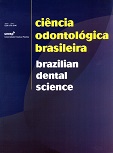Isolamento de Candida spp. com utilização de meio de cultura cromogênico CHROMagar Candida
DOI:
https://doi.org/10.14295/bds.2009.v12i4.641Resumo
O objetivo do presente estudo foi comparar o isolamento e identificação de leveduras do gênero Candida em meio de cultura cromogênico CHROMagar Candida com o isolamento convencional em ágar Sabouraud dextrose com cloranfenicol. Foram coletadas amostras de saliva de 50 indivíduos com idades entre 13 e 70 anos. Os participantes realizaram enxágue bucal com solução fisiológica esterilizada e tamponada com fosfato (PBS) durante 30 s. Essas amostras foram semeadas em CHROMagar Candida e ágar Sabouraud dextrose com cloranfenicol e incubadas a 37°C por 48h. A seguir, foi realizada a contagem de unidades formadoras de colônias (UFC/mL) em CHROMagar Candida e em Agar Sabouraud. Foi realizada a identificação presuntiva das espécies de Candida em CHROMagar através da observação da morfologia e cor das colônias. As colônias de Candida foram isoladas para identificação fenotípica convencional por meio das provas de produção de tubos germinativos, formação de hifas e clamidoconídeos, fermentação e assimilação de açúcares, diferencial de temperatura e urease. Os isolados identificados como C. albicans também foram analisados genotipicamente, pela técnica de Reação em Cadeia da Polimerase, para diferenciação de C. dubliniensis. Os resultados demonstraram que o ágar Sabouraud apresentou maior contagem de leveduras (UFC/mL) em relação ao CHROMagar, entretanto sem diferença estatisticamente significante. O CHROMagar foi eficaz na pré-identificação de Candida albicans e Candida tropicalis. Concluiu-se que ambos os meios foram eficazes para o crescimento de leveduras, sendo que o ágar Sabouraud dextrose com cloranfenicol apresentou maior quantidade de UFC/mL. O CHROMagar possibilitou a identificação presuntiva da maioria das espécies de Candida.
Downloads
Downloads
Publicado
Como Citar
Edição
Seção
Licença
TRANSFERÊNCIA DE DIREITOS AUTORAIS E DECLARAÇÃO DE RESPONSABILIDADE
Toda a propriedade de direitos autorais do artigo "____________________________________________________________________" é transferido do autor(es) para a CIÊNCIA ODONTOLÓGICA BRASILEIRA, no caso do trabalho ser publicado. O artigo não foi publicado em outro lugar e não foi submetido simultaneamente para publicação em outra revista.
Vimos por meio deste, atestar que trabalho é original e não apresenta dados manipulados, fraude ou plágio. Fizemos contribuição científica significativa para o estudo e estamos cientes dos dados apresentados e de acordo com a versão final do artigo. Assumimos total responsabilidade pelos aspectos éticos do estudo.
Este texto deve ser impresso e assinado por todos os autores. A versão digitalizada deverá ser apresentada como arquivo suplementar durante o processo de submissão.




























